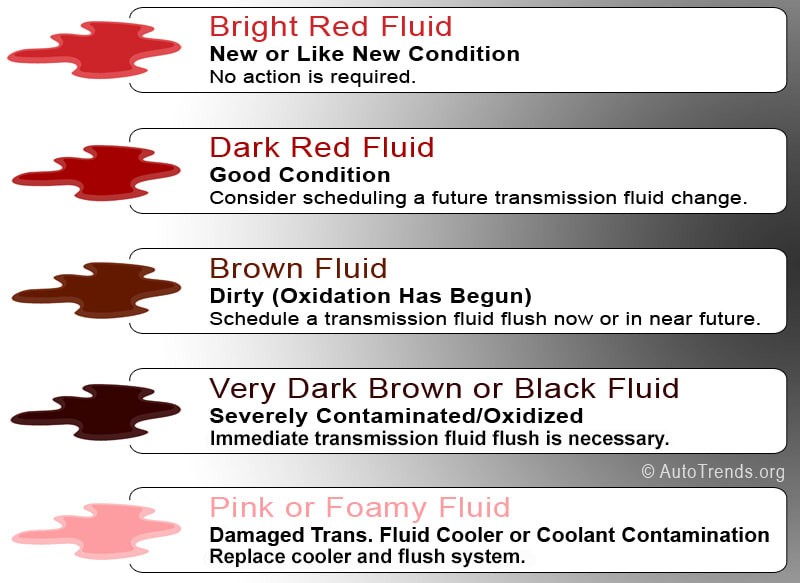What Color Is Transmission Fluid? This is a common question, and at WHAT.EDU.VN, we’re here to provide you with a comprehensive answer and much more. Understanding the color of your transmission fluid is crucial for maintaining your vehicle’s health. We’ll explore everything from identifying healthy fluid to recognizing warning signs through visual inspection and explore the nuances of transmission lubricants and fluid analysis.
1. What is Transmission Fluid and Why Does Color Matter?
Transmission fluid is a vital lubricant that keeps your vehicle’s transmission running smoothly. It protects internal components from wear, cools the transmission, and facilitates gear shifting.
- Lubrication: Reduces friction between moving parts.
- Cooling: Dissipates heat generated during operation.
- Hydraulic Function: Enables smooth gear changes in automatic transmissions.
- Cleaning: Carries away debris and contaminants.
The color of transmission fluid is an indicator of its condition and ability to perform these functions. Changes in color can signal contamination, degradation, or other problems.
2. The Rainbow of Transmission Fluid Colors: A Comprehensive Guide
Understanding the spectrum of transmission fluid colors is key to diagnosing potential problems early. Let’s delve into what each color signifies:
-
2.1. Bright Red: New and Healthy
Fresh transmission fluid is typically a vibrant, translucent red. This indicates that the fluid is new, clean, and functioning optimally. There’s no immediate cause for concern when your fluid is this color.
 Bright red transmission fluid indicates new fluid
Bright red transmission fluid indicates new fluid -
2.2. Dark Red: Normal Aging
Over time, transmission fluid naturally darkens as it’s exposed to heat and friction. A dark red hue generally indicates normal aging and doesn’t necessarily signal a problem. However, it’s a good idea to monitor the fluid’s condition and adhere to your vehicle manufacturer’s recommended maintenance schedule.
-
2.3. Brown or Amber: Oxidation and Degradation
When transmission fluid turns brown or amber, it suggests oxidation and degradation. This means the fluid is losing its lubricating properties and may not be protecting your transmission effectively. A transmission fluid change or flush should be considered soon. This color shift can also indicate overheating, which accelerates fluid breakdown.
-
2.4. Dark Brown or Black: Severe Degradation and Contamination
Dark brown or black transmission fluid is a serious warning sign. It indicates severe degradation, often accompanied by contamination from metallic particles and clutch material. The fluid has lost most of its lubricating properties, and your transmission is at risk of significant damage. Immediate action is needed.
-
2.5. Pink or Milky: Coolant Contamination
Pink or milky transmission fluid is a telltale sign of coolant contamination. This usually occurs due to a leak in the radiator’s internal cooler. Coolant in the transmission can cause severe damage, so this issue requires immediate attention. The milky appearance is due to the coolant mixing with the oil, creating an emulsion.
-
2.6. Gray or Foamy: Air Contamination
Gray or foamy transmission fluid can indicate air contamination, often caused by low fluid levels or a leak in the system. Air bubbles can reduce the fluid’s ability to lubricate and cool, leading to transmission problems.
3. How to Check Your Transmission Fluid Color
Checking your transmission fluid color is a simple yet important maintenance task. Here’s how to do it:
-
3.1. Gather Your Supplies
You’ll need a clean rag or paper towel, gloves (optional), and your vehicle’s owner’s manual.
-
3.2. Locate the Dipstick
Most vehicles have a transmission fluid dipstick, usually located under the hood near the transmission. Consult your owner’s manual to find its exact location. Some newer vehicles may not have a dipstick, requiring a professional to check the fluid.
-
3.3. Prepare Your Vehicle
For the most accurate reading, warm up your engine by driving for a few minutes. Then, park your vehicle on a level surface and engage the parking brake.
-
3.4. Remove and Inspect the Dipstick
Pull out the dipstick, wipe it clean with your rag or paper towel, and reinsert it fully. Then, remove it again and observe the color of the fluid on the dipstick.
-
3.5. Check the Fluid Level
While you’re checking the color, also pay attention to the fluid level. The dipstick should have markings indicating the correct level. If the fluid is low, add the recommended type of transmission fluid.
-
3.6. Consult Your Owner’s Manual
Always refer to your vehicle’s owner’s manual for specific instructions and recommendations regarding transmission fluid checks and maintenance.
4. Factors That Affect Transmission Fluid Color
Several factors can influence the color of your transmission fluid over time:
-
4.1. Heat
High temperatures accelerate the oxidation and degradation of transmission fluid, leading to color changes.
-
4.2. Friction
Friction between moving parts generates heat and causes wear, releasing particles that can contaminate the fluid and darken its color.
-
4.3. Contamination
Contaminants such as water, coolant, dirt, and debris can alter the fluid’s color and compromise its performance.
-
4.4. Fluid Type
Different types of transmission fluid may have slightly different initial colors. Always use the fluid recommended by your vehicle manufacturer.
-
4.5. Driving Conditions
Severe driving conditions, such as towing heavy loads or frequent stop-and-go traffic, can put extra stress on the transmission and accelerate fluid degradation.
5. Addressing Transmission Fluid Problems: Solutions and Maintenance
If you notice any concerning changes in your transmission fluid color, it’s important to take action promptly:
-
5.1. Transmission Fluid Change
A transmission fluid change involves draining the old fluid and replacing it with fresh fluid. This can help restore the fluid’s lubricating properties and remove contaminants. However, a fluid change typically leaves some of the old fluid in the system.
-
5.2. Transmission Fluid Flush
A transmission fluid flush uses specialized equipment to completely remove the old fluid from the transmission, torque converter, and cooler lines. This is a more thorough cleaning process than a fluid change.
-
5.3. Leak Repair
If you suspect a leak, have it diagnosed and repaired by a qualified mechanic. Leaks can lead to low fluid levels and contamination, both of which can damage the transmission.
-
5.4. Professional Inspection
If you’re unsure about the condition of your transmission fluid or notice any other symptoms of transmission problems, have your vehicle inspected by a professional.
6. Symptoms of Transmission Problems
Keep an eye out for these common symptoms of transmission trouble:
- Slipping gears
- Rough or erratic shifting
- Delayed engagement
- Unusual noises (whining, clunking)
- Burning smell
- Check engine light
- Fluid leaks
- Shaking or vibrations
7. Why Regular Transmission Maintenance is Crucial
Regular transmission maintenance is essential for keeping your vehicle running smoothly and avoiding costly repairs. Here’s why:
-
7.1. Extends Transmission Life
Proper maintenance helps prevent wear and tear, extending the life of your transmission.
-
7.2. Improves Performance
Clean, healthy transmission fluid ensures smooth and efficient gear changes, optimizing your vehicle’s performance.
-
7.3. Prevents Costly Repairs
Addressing minor issues early can prevent them from escalating into major problems that require expensive repairs or even transmission replacement.
-
7.4. Maintains Fuel Efficiency
A well-maintained transmission operates more efficiently, which can improve your vehicle’s fuel economy.
-
7.5. Ensures Safety
A properly functioning transmission is crucial for safe driving. Transmission problems can lead to unexpected loss of power or control.
8. Choosing the Right Transmission Fluid
Selecting the correct transmission fluid for your vehicle is critical. Here’s what you need to know:
-
8.1. Consult Your Owner’s Manual
Your vehicle’s owner’s manual will specify the recommended type of transmission fluid. Always follow the manufacturer’s recommendations.
-
8.2. Automatic Transmission Fluid (ATF)
ATF is designed for automatic transmissions and comes in various formulations, such as Dexron, Mercon, and others. Using the wrong type of ATF can damage your transmission.
-
8.3. Manual Transmission Fluid
Manual transmissions typically use gear oil or a specialized manual transmission fluid. Again, refer to your owner’s manual for the correct type.
-
8.4. Synthetic vs. Conventional
Synthetic transmission fluids offer superior performance and durability compared to conventional fluids. They can withstand higher temperatures and provide better protection against wear.
-
8.5. Additives
Some transmission fluids contain additives that enhance their performance, such as friction modifiers, detergents, and corrosion inhibitors.
9. Can You Mix Different Types of Transmission Fluid?
Mixing different types of transmission fluid is generally not recommended. Different fluids may have incompatible additives that can react negatively and compromise the transmission’s performance. Always use the fluid specified in your owner’s manual.
10. Transmission Fluid Color vs. Transmission Fluid Smell
While transmission fluid color is a key indicator, the smell of the fluid can also provide clues about its condition. A burnt or acrid smell often indicates overheating and degradation.
11. Common Misconceptions About Transmission Fluid
Let’s dispel some common myths about transmission fluid:
-
11.1. “Transmission fluid never needs to be changed.”
This is false. While some vehicles have “lifetime” transmission fluid, it’s still a good idea to change it periodically, especially under severe driving conditions.
-
11.2. “Any transmission fluid will work.”
This is also incorrect. Using the wrong type of fluid can damage your transmission.
-
11.3. “A transmission fluid flush is always better than a fluid change.”
Not necessarily. A flush can be beneficial, but it’s not always necessary. Consult a professional to determine the best option for your vehicle.
12. The Role of the Transmission Filter
The transmission filter removes contaminants from the fluid, helping to keep it clean and functioning properly. It’s typically located inside the transmission pan. The filter should be replaced during a transmission fluid change or flush. A clogged filter can restrict fluid flow and damage the transmission.
13. DIY vs. Professional Transmission Service
You can check your transmission fluid color and level yourself, but more complex services like fluid changes and flushes are best left to a professional. They have the expertise, tools, and equipment to perform these tasks correctly and safely.
14. What is Transmission Fluid Dye?
Transmission fluid is often dyed red to distinguish it from other fluids in your car, such as engine oil or coolant. This makes it easier to identify leaks. However, some manufacturers use other colors like blue or purple. The dye doesn’t affect the fluid’s performance.
15. The Future of Transmission Fluid Technology
The automotive industry is constantly evolving, and so is transmission fluid technology. New formulations are being developed to improve performance, extend fluid life, and reduce environmental impact.
16. Transmission Fluid Analysis: A Deeper Dive
For a more comprehensive assessment of your transmission fluid’s condition, consider a fluid analysis. This involves sending a sample of your fluid to a laboratory for testing. The analysis can reveal valuable information about contamination levels, wear metals, and fluid degradation.
17. Transmission Fluid and Environmental Concerns
Used transmission fluid can be harmful to the environment. Dispose of it properly at a recycling center or automotive shop. Never pour it down the drain or onto the ground.
18. Finding Reliable Transmission Service
When you need transmission service, choose a reputable shop with experienced technicians. Look for shops that specialize in transmission repair or have ASE-certified mechanics.
19. Maintaining Your Vehicle’s Value with Transmission Care
Proper transmission maintenance not only keeps your vehicle running smoothly but also helps maintain its value. A well-maintained vehicle is more attractive to potential buyers.
20. Frequently Asked Questions About Transmission Fluid
Let’s address some frequently asked questions about transmission fluid:
| Question | Answer |
|---|---|
| What color should my transmission fluid be? | New fluid is bright red. It darkens over time, but brown or black fluid indicates a problem. |
| How often should I check my transmission fluid? | Check it monthly or every time you check your oil. |
| What happens if my transmission fluid is low? | Low fluid can cause slipping gears, overheating, and damage to the transmission. |
| Can I add transmission fluid myself? | Yes, but be sure to use the correct type of fluid. |
| What does a transmission fluid flush do? | A flush removes all of the old fluid and contaminants from the transmission. |
| How much does a transmission fluid change cost? | The cost varies depending on the vehicle and the type of fluid used. |
| What are the signs of a transmission leak? | Reddish-brown fluid under the car, slipping gears, and difficulty shifting. |
| Is synthetic transmission fluid better than conventional? | Synthetic fluid generally offers better performance and protection. |
| Can I drive with low transmission fluid? | It’s not recommended. Low fluid can cause serious damage. |
| Where can I get my transmission fluid checked? | Any reputable automotive repair shop can check your transmission fluid. |
21. Still Have Questions? Ask WHAT.EDU.VN!
Do you have more questions about transmission fluid or any other automotive topic? Don’t hesitate to ask the experts at WHAT.EDU.VN! We’re here to provide you with free, accurate, and helpful information.
Keeping an eye on your transmission fluid color is a simple way to help ensure the longevity and performance of your vehicle. By understanding the color spectrum and following the maintenance tips outlined in this guide, you can keep your transmission running smoothly for years to come. Remember, when in doubt, consult a professional mechanic.
We understand that finding quick and reliable answers can be challenging. That’s why WHAT.EDU.VN is dedicated to providing a platform where you can ask any question and receive prompt, accurate responses from knowledgeable individuals. Don’t let your curiosity wait – visit WHAT.EDU.VN today and experience the ease of getting your questions answered for free!
Need more help? Contact us today at 888 Question City Plaza, Seattle, WA 98101, United States, or call us on Whatsapp: +1 (206) 555-7890. You can also visit our website WHAT.EDU.VN
Don’t wait any longer! Head over to what.edu.vn and ask your question now. Our community of experts is ready to provide you with the answers you need, completely free of charge.

